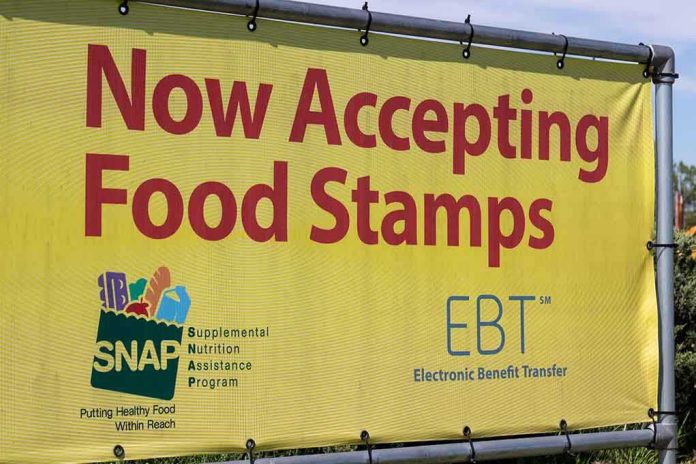
When a president uses the threat of empty dinner tables as a bargaining chip, the real question isn’t about food stamps—it’s about the power plays that put 42 million Americans’ next meals up for political auction.
Story Snapshot
- The Trump administration refused to use emergency funds to extend SNAP benefits during a prolonged government shutdown.
- This reversal of prior USDA guidance put the food security of millions in jeopardy.
- The move escalated pressure on Congress, framing SNAP recipients as pawns in a broader budget standoff.
- Policy experts and advocacy groups argued the administration had both the authority and the obligation to act, sparking intense public debate.
A Policy Reversal That Raised the Stakes
Late October brought more than Halloween chills for millions of Americans—USDA posted an official notice declaring that, come November 1, no more SNAP benefits would reach recipients if the federal shutdown persisted. This announcement marked a sharp reversal from the USDA’s earlier contingency plan, which suggested that multi-year funds could keep food assistance flowing despite a stalled Congress. Suddenly, a temporary inconvenience ballooned into the threat of empty fridges for approximately 42 million people, forcing families and state agencies to brace for impact.
The Trump administration’s public refusal to tap emergency reserves put the onus squarely on lawmakers and, by extension, on the American public’s willingness to tolerate uncertainty in their most basic needs. The timing and tone of the announcement left no doubt: this was a calculated move in a broader political chess match, leveraging the vulnerability of low-income families to hasten a budget resolution. The message was clear—hunger would be used as a prod, not averted by executive action.
How a Shutdown Became a Food Security Crisis
SNAP, the Supplemental Nutrition Assistance Program, has long been the nation’s bulwark against hunger. Its reach—serving tens of millions—makes it not only a lifeline for recipients but a critical cog in local economies, especially for grocers and food retailers. Historically, even during government shutdowns, SNAP benefits continued via contingency funds, providing a buffer that kept food on the table while Washington wrangled over budgets. This time, however, that buffer was deliberately removed. The shutdown, sparked by a standoff over border wall funding, dragged on as USDA officials and the White House pointed fingers at Congress and insisted that without new appropriations, no workaround would be attempted. State agencies, already stretched thin, scrambled to prepare for a scenario in which their most vulnerable citizens could be left with nothing.
As the November 1 deadline loomed, SNAP recipients faced the harrowing possibility of missing out on their only reliable means of affording groceries. Charitable organizations braced for surges in demand, and local businesses anticipated sharp declines in revenue. The shutdown’s ripple effects were poised to reach far beyond the Capitol, touching nearly every community in the country.
Expert Voices and the Clash Over Responsibility
Policy analysts and advocacy groups were quick to point out that the administration’s move broke with both precedent and the USDA’s own earlier guidance. The Center on Budget and Policy Priorities, alongside the Food Research & Action Center, provided detailed legal and practical analyses, concluding that the White House had options to sustain SNAP benefits at least temporarily, if not indefinitely. Critics, including seasoned analysts and hunger advocates, saw the decision as an unnecessarily harsh tactic—one that exploited the needs of the poor to score political points and force congressional action. Some administration officials countered that fiscal responsibility and legal limits tied their hands, but these arguments rang hollow to those who had seen emergency funds used in previous shutdowns.
This was more than a disagreement over budget tactics; it was a public display of the raw power struggle between the executive branch and Congress, with the nation’s food-insecure children, seniors, and disabled individuals caught in the crossfire. The credibility of federal safety net programs now hung in the balance, as did public trust in the government’s willingness to protect its most vulnerable citizens.
Immediate Fallout and Lasting Consequences
The immediate consequences were severe: families faced the prospect of empty pantries, food banks prepared for an emergency spike in demand, and local economies braced for a sudden drop in consumer spending. For many, the damage went beyond hunger—confidence in the reliability of the nation’s safety nets was shaken, raising questions about what other programs might be weaponized in future political battles. In the longer term, experts warned of increased poverty, negative health outcomes, and a deeper erosion of trust in government institutions tasked with protecting America’s most vulnerable. As the standoff dragged on, the debate about SNAP’s future became a litmus test for the nation’s values and the lengths to which leaders would go to achieve their policy goals—even if it meant putting millions at risk of going hungry.
Sources:
Center on Budget and Policy Priorities






